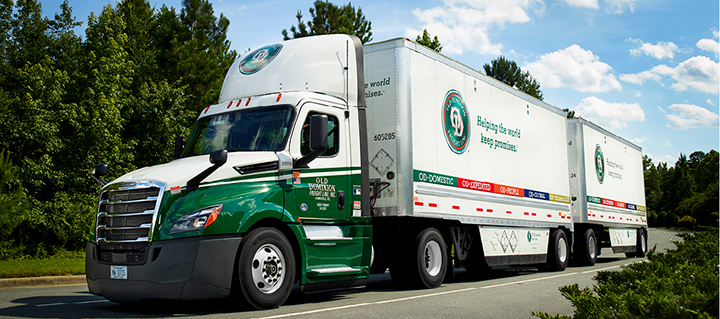THOMASVILLE, N.C. — Last week Old Dominion Freight Line Inc. (ODFL) released financial results for the three- and six-month periods ending June 30. Prior-period share and per share data in the report has been adjusted to reflect the company’s March 2020 three-for-two stock split.
“The second quarter of 2020 was one of the most difficult periods we have experienced, although our ream responded quickly to efficiently manage our operations in this environment,” said Greg Gantt, president and CEO of ODFL, referring to the impact of the global COVID-19 pandemic on the company.
“Given the circumstances with the domestic economy, the decrease in our quarterly revenue was not entirely unexpected. Our overall financial results for the quarter were solid, however, as we continued to execute on the basic elements of our long-term strategic plan,” he continued. “We improved our industry-leading service metrics that support our revenue quality initiatives, and we also balanced our operating costs with the decrease in volumes.”
Despite the difficulties involved in operating a business during COVID-19, Gantt said ODFL continued to provide superior customer service, establishing a new company-record quarterly cargo claims ratio of 0.1% and maintaining on-time deliveries at 99%.
Gantt attributed the drop in revenue during this year’s second quarter, compared to the second quarter of 2019, to a 12.1% decrease in less-than truckload (LTL) tons per day and a 3.8% decrease in LTL revenue per hundredweight.
“Revenue per hundredweight was negatively affected by the significant decline in the average price of diesel fuel and the 5.3% increase in our average weight per shipment, which generally has the effect of reducing revenue per hundredweight,” he said, adding that, excluding fuel surcharges, ODFL’s LTL revenue per hundredweight decreased 0.5% compared to 2019.
In addition, changes in the company’s mix of freight resulted in a negative impact on yield metrics, but Gantt said the company’s underlying pricing performance remained consistent with prior periods.
“We intend to maintain our long-term and consistent approach to pricing, as we believe this approach supports our ability to achieve long-term profitable growth,” he said.
During April, the company experienced a significant decrease in revenue per day, which Gantt attributes to shelter-in-place orders issued around the country.
“As these stay-at-home mandates were phased out and our customers began to reopen their businesses, our revenue trend improved on a sequential basis for the remaining months of the quarter,” he noted. “Although year-over-year volumes decreased for both May and June when compared to the same periods of 2019, we were encouraged by the sequential improvement in our volumes that has also continued into July.”
ODFL’s operating ratio showed a slight improvement during the second quarter, rising from 77.8% to 77.9%.
“This improvement in our direct costs more than offset the increase in overhead costs as a percent of revenue,” Gantt said.
“We attribute the increase in our overhead costs as a percent of revenue to the deleveraging effect associated with the reduction in revenue, despite our diligence in controlling our discretionary spending,” he explained. “While we were pleased with the improvement in our operating ratio during the quarter, we were careful to balance short-term cost decisions in a challenging economic environment against the long-term needs of our business. As a result, our service advantage and available capacity position us to capitalize on future revenue growth opportunities.”
ODFL’s net cash provided by operating activities was $312.2 million for the second quarter of 2020 and $516.2 million for the first half of the year. The company had $518.6 million in cash and cash equivalents on June 30.
Capital expenditures were $67.9 million for the second quarter of 2020 and $120.1 million for the first half of the year. ODFL expects its aggregate capital expenditures for 2020 to total approximately $265 million, including planned expenditures of $195 million for real estate and service-center expansion projects; $20 million for tractors and trailers; and $50 million for information technology and other assets.
The company returned $146.1 million of capital to its shareholders in the second quarter of 2020 and $342.7 million for the first half of the year. For the year-to-date period, this total consisted of $306.8 million of share repurchases and $35.9 million of cash dividends.
“Old Dominion’s second quarter results are a testament to the resiliency of our business model and the consistent execution of our strategic plan. We remain committed to ensuring the safety and well-being of our OD Family of employees, who in turn remain dedicated to providing our customers with superior service at a fair price,” Gantt said.
“This value proposition differentiates us from our competition and is critical to our ability to win market share. We are encouraged by recent trends and will continue to invest in the necessary elements of capacity to support our customers’ needs,” he said. “Our long-term record of success throughout the various stages of the economic cycle provides us with confidence that executing on the fundamental aspects of our business can deliver additional value to our shareholders.”
The Trucker News Staff produces engaging content for not only TheTrucker.com, but also The Trucker Newspaper, which has been serving the trucking industry for more than 30 years. With a focus on drivers, the Trucker News Staff aims to provide relevant, objective content pertaining to the trucking segment of the transportation industry. The Trucker News Staff is based in Little Rock, Arkansas.








